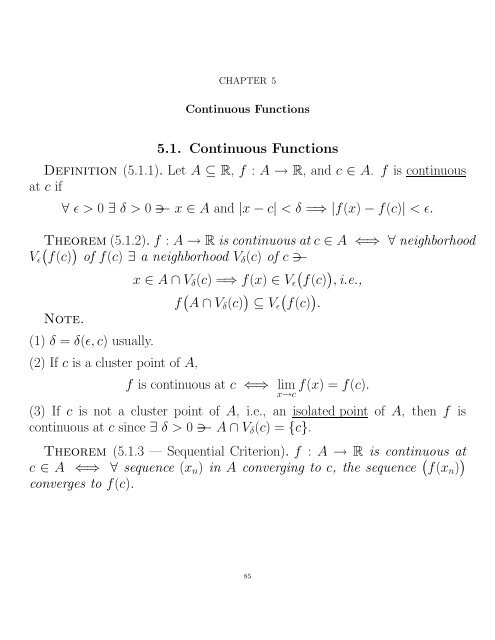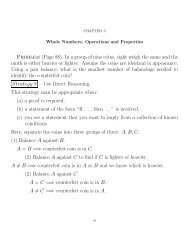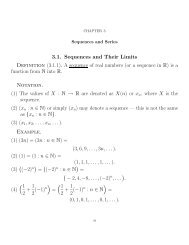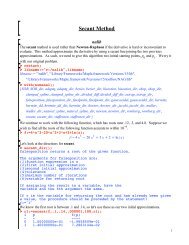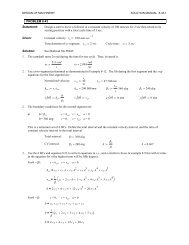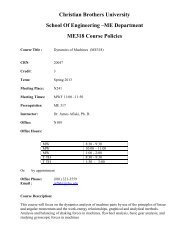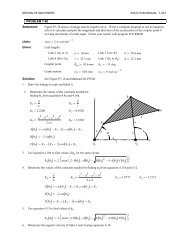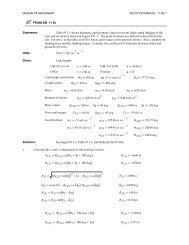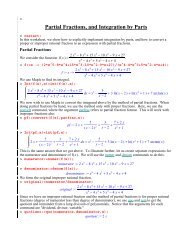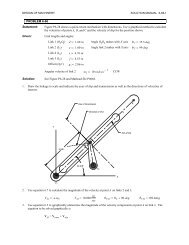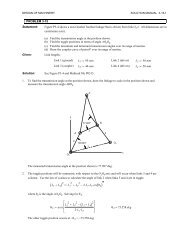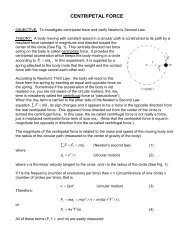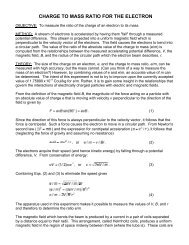5.1. Continuous Functions Definition (5.1.1). Let A â R, f : A ... - CBU
5.1. Continuous Functions Definition (5.1.1). Let A â R, f : A ... - CBU
5.1. Continuous Functions Definition (5.1.1). Let A â R, f : A ... - CBU
Create successful ePaper yourself
Turn your PDF publications into a flip-book with our unique Google optimized e-Paper software.
CHAPTER 5<strong>Continuous</strong> <strong>Functions</strong><strong>5.1.</strong> <strong>Continuous</strong> <strong>Functions</strong><strong>Definition</strong> (<strong>5.1.</strong>1). <strong>Let</strong> A ✓ R, f : A ! R, and c 2 A. f is continuousat c if8 ✏ > 0 9 > 0 3 x 2 A and |x c| < =) |f(x) f(c)| < ✏.Theorem (<strong>5.1.</strong>2). f : A ! R is continuous at c 2 A () 8 neighborhoodV ✏ f(c) of f(c) 9 a neighborhood V (c) of c 3Note.(1) = (✏, c) usually.(2) If c is a cluster point of A,x 2 A \ V (c) =) f(x) 2 V ✏ f(c) , i.e.,f A \ V (c) ✓ V ✏ f(c) .f is continuous at c () lim f(x) = f(c).x!c(3) If c is not a cluster point of A, i.e., an isolated point of A, then f iscontinuous at c since 9 > 0 3 A \ V (c) = {c}.Theorem (<strong>5.1.</strong>3 — Sequential Criterion). f : A ! R is continuous atc 2 A () 8 sequence (x n ) in A converging to c, the sequence f(x n )converges to f(c).85
86 5. CONTINUOUS FUNCTIONSTheorem (<strong>5.1.</strong>4 — Discontinuity Criterion). <strong>Let</strong> A ✓ R, f : A ! R, andc 2 A. f is discontinuous at c ()9 a sequence (x n ) in A 3 lim(x n ) = c but lim f(x n ) 6= f(c).<strong>Definition</strong> (<strong>5.1.</strong>5). <strong>Let</strong> A ✓ R and f : A ! R. If B ✓ A,f is continuous on B if f is continuous at every point of B.Example.(1) f(x) = L, L 2 R, x 2 R.lim f(x) = lim L = L = f(c) 8 c 2 R,x!c x!cso f is continuous on R.(2) f(x) = xso f is continuous on Rlim f(x) = lim x = c = f(c),x!c x!c(3) It can be shown that1x6 x3 apple sin x apple x for x 0 and x apple sin x apple xThus116 x2 apple sin x apple 1 8x 2 R.xSince⇣1⌘lim 1x!0 6 x2 = lim 1 = 1,x!0sin xlimx!0 x = 1.16 x3 for x apple 0.
<strong>5.1.</strong> CONTINUOUS FUNCTIONS 87<strong>Definition</strong>. If f is discontinuous at c, but lim f(x) exists, then x = c isx!ccalled a removable discontinuity of f since(f(x), if x 6= cis continuous at c.g(x) =lim f(x),x!cNote. We are definining or redefining f(c).Thusg(x) =is continuous at x = 0 (on R, in fact).if x = c8< sin x, if x 6= 0x: 1, if x = 0(4) The characteristic function of the set A ✓ R is(1, if x 2 AA(x) =0, if x 62 A .(x) = Q (x) =(1, if x 2 Q0, if x 62 Qis discontinuous everywhere since every neighborhood of c 2 R contains infinitelymany rationals and irrationals.(5) A function continuous at x = 0 only isf(x) = x (x).This has already been proved as Page 104 #14.Also, for {a 1 , a 2 , . . . , a n }, a i 6= a j for i 6= j,f(x) = (x)(x a 1 )(x a 2 ) · · · (x a n )is continuous on {a 1 , a 2 , . . . , a n }, but nowhere else.
88 5. CONTINUOUS FUNCTIONS(6) The Ruler (Thomae’s) function8< 0, if x 62 Qf(x) = 1:n , if x 2 Q with x = m n , n 2 N, m in lowest termsnis continuous at each irrational and discontinuous at each rational (graph is onPage 127).Proof.(a) Suppose c 2 Q. <strong>Let</strong> (x n ) be a sequence of irrationals with lim(x n ) = c.Then lim f(x n ) = 0 6= f(c). thus f(x) is discontinuous at x = c.(b) Suppose c 2 R\Q and ✏ > 0. By the Archimedean Property,9 n 0 2 N 3 1 n 0< ✏. Now 9 only a finite number of rationals in (c 1, c + 1)with denominator less than n 0 .Choose > 0 3 (c , c + ) contains no rationals with denominator lessthan n 0 . thenx 2 R and |x c| < =) |f(x) f(c)| = |f(x)| = f(x) apple 1 n 0< ✏.Thus f is continuous at x = c.⇣ 1(7) f(x) = x sin . Is the discontinuity at x = 0 removable?x⌘⇣ 1⌘Yes, since lim x sin = 0.x!0 xProof.⇣ 1|f(x) 0| = x sin apple |x| ! 0 as x ! 0.x⌘Thenis continuous on R.f(x) =8 ⇣< 1x sin , if x 6= 0x⌘: 0, if x = 0⇤⇤
<strong>5.1.</strong> CONTINUOUS FUNCTIONS 89(8) Any polynomial p(x) is continuous on R since limx!cp(x) = p(c).(9) Any rational function f(x) = p(x) , where p(x) and q(x) are polynomials,q(x)p(x)is continuous on {x : q(x) 6= 0} since limx!c q(x) = p(c) on this set.q(c)(10) f(x) = x2 1is continuous except at x = 1. Sincex 1x 2 1limx!1 x 1 = lim (x + 1)(x 1)= lim(x + 1) = 2,x!1 x 1 x!1the discontinuity at x = 1 is removable. Thus8< x 2 1, if x 6= 1F (x) = x 1 = x + 1:2, if x = 1is continuous on R.HomeworkPages 129-30 # 5, 7, 8, 12Pag 134 # 8 (Hint: Use Problem 8 from Page 129)
90 5. CONTINUOUS FUNCTIONS5.2. Combinations of <strong>Continuous</strong> <strong>Functions</strong>Theorem (5.2.1). <strong>Let</strong> A ✓ R, f, g : A ! R, and b 2 R. Suppose c 2 Aand f and g are continuous at c.(a) Then f ± g, fg, and bf are continuous at c.(b) If g(x) 6= 0 8 x 2 A, then f gExample.(1) sin x and cos x are continuous on R.Proof. Facts from Trigonometry:is continuous at c.|sin z| apple |z|, |cos z| apple 1, |sinz| apple 1h 1i h 1isin x sin y = 2 sin2 (x y) cos2 (x + y) h 1i h 1icos x cos y = 2 sin2 (x + y) sin2 (y x)Then:|sin x sin y| = 2 sin 1 2 (x y) · cos 1 2and1(x + y) apple 2 · |x y| · 1 = |x y|2|cos x cos y| = 2 sin 1 2 (x + y) sin 1 1(y x) apple 2 · 1 · |x y| = |x y|.2 2For each function, just choose = ✏. ⇤Theorem (5.2.4). <strong>Let</strong> A ✓ R and f : A ! R. Define |f| : A ! R by|f|(x) = |f(x)|. If f is continuous at c, then |f| is continuous at c.Note. limx!c|f(x)| = |limx!cf(x)|.
5.2. COMBINATIONS OF CONTINUOUS FUNCTIONS 91Theorem (5.2.5). <strong>Let</strong> A ✓ R, f : A ! R, and f(x) 0 8 x 2 A.Define p f : A ! R by p f(x) = p f(x). If f is continuous at c 2 A, thenp f is continuous at c.Recall (g f)(x) = g ⇥ f(x) ⇤ . This requires range f ✓ domain g.Theorem (5.2.6). <strong>Let</strong> A, B ✓ R, f : A ! R, g : B ! R, and f(A) ✓ B.If f is continuoius at c 2 A and g is continuous at b = f(c) 2 B, theng f : A ! R is continuous at c.Proof. <strong>Let</strong> ✏ > 0 be given. Since g is continuous at f(c),9 > 0 3 y 2 B and |y f(c)| < =) g(y) g ⇥ f(c) ⇤ < ✏.Since f is continuous at c,9 > 0 3 x 2 A and |x c| < =)f(x) f(c) < =) g ⇥ f(x) ⇤ g ⇥ f(c) ⇤ < ✏.Thus g f is continuous at c. ⇤HomeworkPages 133-4 # 1 (just give the points of continuity),3, 7
92 5. CONTINUOUS FUNCTIONS5.3. <strong>Continuous</strong> <strong>Functions</strong> on Intervals<strong>Definition</strong> (5.3.1). f : A ! R is bounded on A if9 M > 0 3 |f(x)| apple M 8 x 2 A.Note. <strong>Continuous</strong> functions are not necessarily bounded.Theorem (5.3.2 — Boundedness Theorem). <strong>Let</strong> I = [a, b] be a closed,bounded interval and let f : I ! R be continuous on I. Then f is boundedon I.Proof. Suppose f is not bounded on I. Then, 8 n 2 N,9 x n 2 I 3 |f(x n )| > n. Since I is bounded, X = (x n ) is bounded.By the B-W Theorem, X has a subsequence X 0 = (x nk ) 3lim(x nk ) = x 2 I (by Theorem 3.2.6). Since f is continuous at x,lim f(x nk ) = f(x). But thenf(x nk )is bounded, contradicting thatThus f must be bounded on I.f(x nk ) > n k k 8 k 2 N.<strong>Definition</strong> (5.3.3). let A ✓ R and f : A ! R. f has an absolute maximumon A if9 x ? 2 A 3 f(x ? ) f(x) 8 x 2 A.f has an absolute minimum on A if9 x ? 2 A 3 f(x ? ) apple f(x) 8 x 2 A.⇤
5.3. CONTINUOUS FUNCTIONS ON INTERVALS 93Theorem (5.3.4 — Maximum-Minimum Theorem). <strong>Let</strong> I = [a, b] be aclosed, bounded interval and f : I ! R be continuous on I. Then f hasan absolute maximum and an absolute minimum on I.Proof. f(I) is nonempty and bounded(by the previous theorem). Thens ? = sup f(I) and s ? = inf f(I) exist.[To show 9 x ? , x ? 2 I 3 f(x ? ) = s ? and f(x ? ) = s ? . Then f(x ? ) is theabsolute maximum and f(x ? ) is the absolute minimum on I.](a) Since s ? = sup f(I), 8 n 2 N, 9 x n 2 I 3(#) s ? 1n < f(x n) apple s ? .Since I is bounded, (x n ) is bounded,so has a subsequence (x nk ) 3 lim(x nk ) = x ? 2 I (from B-W and Theorem3.2.6). But f is continuous at x ? , soBy (#),lim f(x nk ) = f(x ? ).s ? 1n k< f(x nk ) apple s ? 8 k 2 N.By the Squeeze Theorem,(b) Similar.f(x ? ) = lim f(x nk ) = s ? .⇤
94 5. CONTINUOUS FUNCTIONSTheorem (5.3.7 — Bolzano’s Intermediate Value Theorem). <strong>Let</strong> I be aninterval and f : I ! R be continuous on I. If a, b 2 I and k 2 R 3f(a) < k < f(b), then 9 c 2 I between a and b 3 f(c) = k.Proof. WLOG, assume a < b (the other case is similar).<strong>Let</strong> S = {x 2 [a, b] : f(x) < k}.Since a 2 S, S 6= ;. By the Supremum Theorem,9 c 2 [a, b] 3 c = sup S. Then18 n 2 N, 9x n 2 S 3 cn < x n apple c.Thus lim(x n ) = c by the Squeeze Theorem, and since f(x n ) < k 8 n 2 N,lim f(x n ) apple k. Since f is continuous at c,f(c) = lim f(x n ) apple k.[To show f(c) k also =) f(c) = k.]nNow let y n = min b, c + 1 n 8 n 2 N.Since c < y n apple c + 1 n , lim(y n) = c by the Squeeze Theorem. [Where is y n ?]Now, 8 n 2 N, y n 2 [a, b]\S, so f(y n ) k.Again, by continuity at c,f(c) = lim f(y n ) k =) f(c) = k.
5.3. CONTINUOUS FUNCTIONS ON INTERVALS 95⇤Corollary (5.3.8). <strong>Let</strong> I = [a, b] be a closed, bounded interval andf : I ! R be continuous on I. Ifthen 9 c 2 I 3 f(c) = k.inf f(I) apple k apple sup f(I),Proof. From the Maximum-Minimum Theorem, 9 c ? , c ? 2 I 3inf f(I) = f(c ? ) apple k apple f(c ? ) = sup f(I)The conclusion follows from Bolzano’s IVT.Theorem (3.5.9). <strong>Let</strong> I = [a, b] be a closed, bounded interval and f :I ! R be continuous on I. Then the set f(I) = {f(x) : x 2 I} is a closed,bounded interval.Proof. m = inf f(I) 2 f(I) and M = sup f(I) 2 f(I) by the Maximum-Minimum Theorem. Clearly, f(I) ✓ [m, M]. If k 2 [m, M], by Corollary5.3.7, 9 c 2 I 3 k = f(c). Then k 2 f(I), so [m, M] ✓ f(I). Thusf(I) = [m, M].⇤Theorem (5.3.10 — Preservation of Intervals Theorem). If I is an intervaland f : I ! R is continuous on I, then f(I) is an interval.Proof. <strong>Let</strong> ↵, 2 f(I) with ↵ < . Then 9 a, b 2 I 3 ↵ = f(a) and= f(b). From Bolzano’s IVT,k 2 (↵,) =) 9 c 2 I 3 k = f(c) 2 f(I).Thus [↵, ] ✓ f(I), so f(I) is an interval by Theorem 2.<strong>5.1.</strong> ⇤HomeworkPages 140-41 # 1 ,3, 5⇤
96 5. CONTINUOUS FUNCTIONS5.4. Uniform ContinuityExample.(1) f(x) = 1 is continuous on (0, 1). <strong>Let</strong> u > 0 and ✏ > 0 be given.x2 Since f is continuous at u, 9 > 0 3 |x u| < =) |f(x) f(u)| < ✏.[How to pick ?]Take|f(x) f(u)| = 1 x 2 1u 2 = u2 x 2x 2 u 2 =apple u 2 . Then|x u| < =) |x u| < u 2 =) u 2 < x u < u 2 =)Thenif |x|f(x) f(u)| =5u|x + u|x 2 u |x u| < 22|x + u||x u|.x 2 u2 u2 < x < 3u 2 =) 3u 2 < x + u < 5u 2 .u22u2nu| < ✏u3u10 also. So take = min 2 , ✏u310Suppose ✏ = 1 4 .n 3If u = 3, take = min2 40o, 9 = .225.|x u| =10u 3|xu| < ✏o. Notice = (u, ✏).If u = 1 , take2= min{.25, .000390625} = .000390625.If u = 1 , take100= min{.005, .000000025} = .000000025.It turns out to be very useful to know whenon u.= (✏) only, without dependence
5.4. UNIFORM CONTINUITY 97<strong>Definition</strong> (5.4.1). <strong>Let</strong> A ✓ R and f : A ! R. f is uniformly continuous(u.c.) on A if8 ✏ > 0 9 (✏) > 0 3 x, u 2 A and |x u| < (✏) =) |f(x) f(u)| < ✏.Note. Uniform continuity =) continuity.Example.(1) f(x) = 1 is u.c. on [a, 1) where a > 0.x2 Proof. <strong>Let</strong> ✏ > 0 be given. Then|x + u| x + u|f(x) f(u)| = |x u| = |x u| =x 2 u2 x 2 u2 ⇣ 1xu + 1 ⌘ ⇣ 1|x u| apple2 x 2 ua + 1 ⌘|x u| = 2 3 a 3 a3|x u| < ✏if |x u| < a3 ✏2 . Take = a3 ✏2 . Thenx, u 2 A and |x u| < =) |f(x) f(u)| < ✏.So f is u.c. on [a, 1).Theorem (5.4.2 — Nonuniform Continuity Criterion). <strong>Let</strong> A ✓ R andf : A ! R. TFAE:(1) f is not u.c. on A.(2) 9✏ 0 > 0 3 8 > 0 9x , u 2 A 3 |x u | < and |f(x ) f(u )| ✏ 0 .(3) 9 ✏ 0 > 0 and two sequences (x n ) and (u n ) in A 3 lim(x n u n ) = 0 and|f(x n ) f(u n )| ✏ 0 8 n 2 N.⇤
98 5. CONTINUOUS FUNCTIONSExample.(2) f(x) = 1 is not u.c. on (0, 1) (or on (0, a]).x2 Proof. <strong>Let</strong> x n = p 11and u n = p .n n + 1but|x n u n | = 1 p n1p n + 1apple 1 p n+1p n + 1! 0 as n ! 1,|f(x n ) f(u n )| = |n (n + 1)| = 1 8 n 2 N.Theorem (5.4.3 — Uniform continuity Theorem). <strong>Let</strong> I = [a, b] be aclosed, bounded interval and f : I ! R be continuous on I. Then f isuniformly continuous on I.Proof. Suppose f is not u.c. on I. Then 9 ✏ 0 > 0 and two sequences (x n )and (u n ) in A 3 (x n u n ) < 1 n and |f(x n) f(u n )| ✏ 0 8 n 2 N.Since I is bounded, (x n ) is bounded, so by B-W and Theorem 3.2.69 a subsequence (x nk ) of (x n ) 3 lim(x nk ) = z 2 I. Since|u nk z| = |u nk x nk + x nk z| apple |u nk x nk | + |x nk z| ! 0,lim(u nk ) = z also. Since f is continuous at z,solim f(x nk ) = f(z) = lim f(u nk ) ,|f(x nk ) f(u nk )| = |f(x nk ) f(z) + f(z) f(u nk )| applecontradicting |f(x nk ) f(u nk )| ✏ 0 8 k 2 N.Thus f is u.c. on I.|f(x nk ) f(z)| + |f(z) f(u nk )| ! 0,⇤⇤
Example.(3) f(x) = x 73 is u.c. on [ 13, 13].(4) f(x) = p x is u.c. on [0, 400].5.4. UNIFORM CONTINUITY 99(5) f(x) = x 17 sin e x e 4x cos(2x) is u.c. on [ 8⇡, 8⇡].(6) f(x) = 1 x 6 is u.c. on h14 , 44 i.What if f is continuous on a set that is not a closed, bounded interval?<strong>Definition</strong> (5.4.4). <strong>Let</strong> A ✓ R and F : A ! R. If9 K > 0 3 |f(x) f(u)| apple K|x u| 8 x, u 2 A,then f is a Lipschitz function (or satisfies a Lipschitz condition) on A.Note. This is equivalent tof(x) f(u)apple Kx uon I, i.e., the slopes with all line segments with endpoints in I is bounded byK.Theorem (5.4.5). If f : A ! R is a Lipschitz function on A, then f isuniformly continuous on A.TakeProof. Given ✏ > 0. Suppose f is Lipschitz with constant K.= ✏ K . Thenx, u 2 A and |x u| < =) |f(x) f(u)| apple K|x u| < K · ✏K = ✏.Thus f is u.c. on A.⇤
100 5. CONTINUOUS FUNCTIONSExample.(7) f(x) = x 1/3 is u.c. on (1, 1).Proof.|f(x) f(u)| = |x 1/3 u 1/3 |x u|| =x 2/3 + x 1/3 u 1/3 + u < 1 2/3 3 |xThus f is Lipschitz and u.c. on (1, 1).(8) g(x) = p x is u.c. on [0, 2] but not Lipschitz since| p p 1x u| = p p |x u|x + uu|.⇤and1p x +p uis unbounded as x, u ! 0.Thus u.c. 6=) Lipschitz.Problem (Page 148 # 12). If f is continuous on [0, 1) and u.c. on [a, 1)for some a > 0, then f is u.c. on [0, 1).Proof. <strong>Let</strong> ✏ > 0 be given. Since f is continuous on [0, 1),f is u.c. on [0, a + 1]. Thus9 0 < 1 < 1 3 x, u 2 [0, a + 1] and |x u| < 1 =) |f(x) f(u)| < ✏.Since f is u.c. on [a, 1),<strong>Let</strong>9 0 < 2 < 1 3 x, u 2 [a, 1) and |x u| < 2 =) |f(x) f(u)| < ✏.= min{ 1 , 2}. Then|x u| < =) x, u 2 [0, a + 1] or x, u 2 [a, 1) =) |f(x) f(u)| < ✏.Thus f is u.c. on [0, 1).⇤
5.4. UNIFORM CONTINUITY 101What about u.c. on open intervals?Theorem (5.4.7). If f : A ! R is u.c. and if (x n ) is a Cauchy sequencein A, then f(x n ) is a Cauchy sequence in R.Proof. <strong>Let</strong> (x n ) be a Cauchy sequence in A and ✏ > 0 be given.Since f is u.c. on A,9 > 0 3 x, u 2 A and |x u| < =) |f(x) f(u)| < ✏.Since (x n ) is Cauchy,9 H 2 N 3 n, m H =) |x n x m | < .But thenn, m H =) |f(x n ) f(x m )| < ✏.Thus f(x n ) is Cauchy. ⇤Example.(9) g(x) = 1 is not u.c. on (0, 1).x2 ⇣ 1Proof. ! 0 on (0, 1), so is Cauchy on (0, 1), butn⌘✓ ◆ ✓ ◆1 1=x2 n1 2= (n 2 )ndiverges, so is not Cauchy. Thus g(x) is not u.c. on (0, 1).⇤
102 5. CONTINUOUS FUNCTIONSTheorem (5.4.8 — <strong>Continuous</strong> Extension Theorem). f is u.c. on (a, b) ()it can be defined at the endpoints a and b 3 the extended function f iscontinuous on [a, b].Proof.((=) f continuous on [a, b] =) f is u.c. on [a, b] =) f is u.c. on (a, b) byrestriction.(=)) Suppose f is u.c. on (a, b).[We extend f to a. Extending f to b is similar.]<strong>Let</strong> (x n ) be a sequence in (a, b) 3 lim(x n ) = a.Then (x n ) is Cauchy =) f(x n ) is Cauchy =)9L 2 R 3 lim f(x n ) = L.Suppose (u n ) is any other sequence in A 3 lim(u n ) = a.Then lim(u n x n ) = a a = 0.Since f is u.c. on (a, b),lim f(u n ) = lim f(u n ) f(x n ) + f(x n ) =lim f(u n ) f(x n ) + lim f(x n ) = 0 + L = L.Then limx!af(x) = L by the sequential criterion for limits.Defining f(a) = L gives a continuous extension.⇤
Example.(10) f(x) = sin xxProof.5.4. UNIFORM CONTINUITY 103is u.c. on (0, b) 8 b > 0.sin xlimx!0 xDefine f(0) = 1 and f(b) = sin b⇣ 1(11) g(x) = sinx⌘sin x= 1 and limx!b xb .= sin bb .⇣ 1⌘is not u.c. on (0, 1) since lim sinx!0 xDNE.⇤HomeworkPages 148-49 # 1, 3b(E1) Show f(x) = x 3 is u.c. on (0, 2)(E2) Show f(x) = sin(x 2 ) is not u.c. on R(E3) Show f(x) = p x is u.c. on [0, 1).Hint: use 5.4.2(iii)(E4) Is f(x) = 1 u.c. on (0, 1)? Prove.x3


